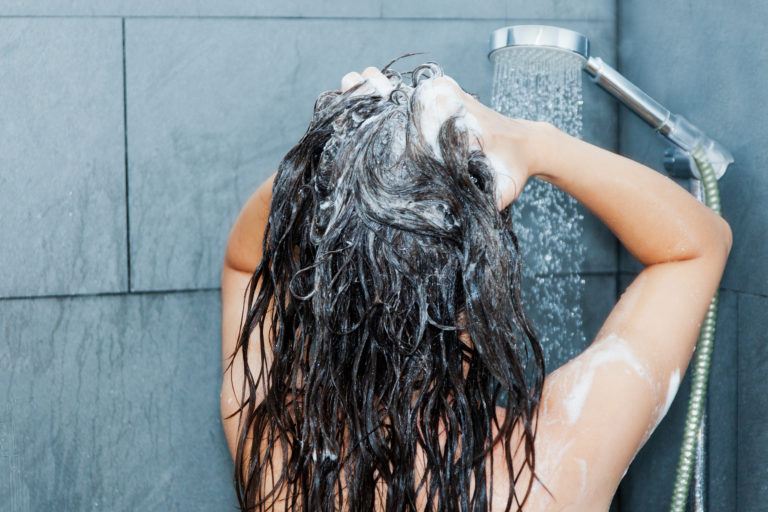
Quick Tips
- First, brush or comb your hair from scalp to ends.
- Wash your body as usual and get your hair wet.
- Wash your hair and scalp with the baking soda solution.
- Rinse well.
- Rinse with apple cider vinegar, then again with plain water.
- Style as desired.
I clean a lot of things with baking soda and vinegar, but it would never have occurred to me to use them on my own head. In fact, when I first started looking at recipes for homemade, natural shampoo, I was a little unnerved by the idea of washing my hair with the same products I use to clean the toilet and scrub wine stains off my kitchen counters. But now that I know how many people are doing this (it’s more common than you’d think) and all of the logical reasons they have for doing it, you might even call me a convert.
Shampoo is a relatively recent invention, and while it’s a clear improvement over what most people used before it—drying, residue-leaving soap—it has its shortcomings. For one thing, it obliterates the oils your body produces to naturally moisturize your hair and scalp, which is nice, except that your body responds by producing more of those oils, also known as sebum. This increased oil production makes you want to shampoo more often, stripping the sebum before it gets a chance to moisturize your hair. So your hair and scalp dry out and you’re forced to replace the natural oils with another new-ish product: conditioner. This constant balancing act not only lets dozens of chemicals seep into your body through your skin; it can also get pretty expensive. Baking soda and apple cider vinegar, on the other hand, are two of the cheapest things in the grocery store. And because they leave a small amount of natural oil on your scalp, your body gets a chance to find its own balance. Here’s how it works.
How to Wash Hair Without Shampoo
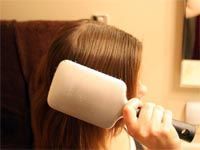 First, brush or comb your hair from scalp to ends.Doing this just before you hop in the shower will loosen clingy particles of grime and distribute oil all the way down the strands of your hair. And that’s good, remember, not gross, because it helps to moisturize the hair. One other thing you’ll probably want to do before getting wet is stir one tablespoon of baking soda into one cup of warm water. If you decide you’ll be doing this on a regular basis, you may want to keep a squeeze bottle full of this solution in your shower; just shake it well before each wash.
First, brush or comb your hair from scalp to ends.Doing this just before you hop in the shower will loosen clingy particles of grime and distribute oil all the way down the strands of your hair. And that’s good, remember, not gross, because it helps to moisturize the hair. One other thing you’ll probably want to do before getting wet is stir one tablespoon of baking soda into one cup of warm water. If you decide you’ll be doing this on a regular basis, you may want to keep a squeeze bottle full of this solution in your shower; just shake it well before each wash.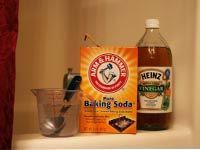 Wash your body as usual and get your hair wet. One of the nice things about this particular method of natural hair care is that your normal shower routine can remain more or less the same, since you’re still using two products on your hair. The only change I made was to save my hair for last instead of letting the products sit on my head while I did my soaping-up and shaving, which is what I would normally do with shampoo and conditioner.
Wash your body as usual and get your hair wet. One of the nice things about this particular method of natural hair care is that your normal shower routine can remain more or less the same, since you’re still using two products on your hair. The only change I made was to save my hair for last instead of letting the products sit on my head while I did my soaping-up and shaving, which is what I would normally do with shampoo and conditioner.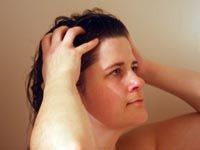 Wash your hair and scalp with the baking soda solution. Pour it over your damp hair, massage your scalp with your fingertips for several seconds, and then let the solution sit on your head for about one minute before rinsing. Since everyone’s hair texture and body chemistry are different, you may need to play with the ratio of baking soda to water a little until you find the right mixture for you. Just keep in mind that using too much baking soda can make your hair dry and brittle.
Wash your hair and scalp with the baking soda solution. Pour it over your damp hair, massage your scalp with your fingertips for several seconds, and then let the solution sit on your head for about one minute before rinsing. Since everyone’s hair texture and body chemistry are different, you may need to play with the ratio of baking soda to water a little until you find the right mixture for you. Just keep in mind that using too much baking soda can make your hair dry and brittle.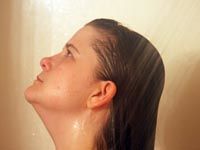 Rinse well. My hair felt a little “squeaky” once I rinsed the baking soda out of it, which I took as a sign that it was clean. Like most people, I’ve learned to associate suds with cleaning, so even though I know that shampoo only lathers because of added foaming agents like sodium lauryl (or laureth) sulfate, it seemed weird not to work up a lather while massaging my scalp. What really matters in the end is that baking soda has a slightly alkaline pH to dissolve excess dirt and oil. However, since leaving an alkaline solution on your scalp can gradually weaken your hair, you should follow up with an acidic vinegar rinse to restore your hair and scalp to a slightly less than pH-neutral state.
Rinse well. My hair felt a little “squeaky” once I rinsed the baking soda out of it, which I took as a sign that it was clean. Like most people, I’ve learned to associate suds with cleaning, so even though I know that shampoo only lathers because of added foaming agents like sodium lauryl (or laureth) sulfate, it seemed weird not to work up a lather while massaging my scalp. What really matters in the end is that baking soda has a slightly alkaline pH to dissolve excess dirt and oil. However, since leaving an alkaline solution on your scalp can gradually weaken your hair, you should follow up with an acidic vinegar rinse to restore your hair and scalp to a slightly less than pH-neutral state.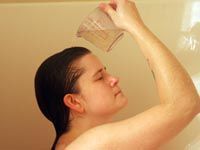 Rinse with apple cider vinegar, then again with plain water. Add one tablespoon of apple cider vinegar to one cup of warm water and pour the mixture over your head. Again, massage your scalp a bit with your fingertips and let the solution sit for about a minute before rinsing it out. When I rinsed this time, my hair felt soft and smooth, with none of the squeakiness left behind by the baking soda. If you’ll be washing your hair this way on a regular basis, you can add essential oils or sprigs of herbs to your squeeze bottle of vinegar and water to change how it smells or affects your hair.
Rinse with apple cider vinegar, then again with plain water. Add one tablespoon of apple cider vinegar to one cup of warm water and pour the mixture over your head. Again, massage your scalp a bit with your fingertips and let the solution sit for about a minute before rinsing it out. When I rinsed this time, my hair felt soft and smooth, with none of the squeakiness left behind by the baking soda. If you’ll be washing your hair this way on a regular basis, you can add essential oils or sprigs of herbs to your squeeze bottle of vinegar and water to change how it smells or affects your hair.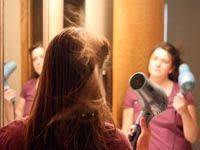 Style as desired. I was surprised at how tangle-free my hair was when I got out of the shower, and the only difference I noticed when it dried was that it seemed lighter and had more body, probably because it wasn’t weighed down by residues from shampoo and conditioner. So feel free to air dry, blow dry, use a sea salt spritz to encourage natural waves, smooth a few drops of coconut oil over it for extra moisture, or do anything else that normally makes your hair look and feel great. But don’t get too discouraged if your hair doesn’t look fabulous right away: some people experience a transition period of slightly greasy hair for up to six weeks while the scalp scales back its production of oil.
Style as desired. I was surprised at how tangle-free my hair was when I got out of the shower, and the only difference I noticed when it dried was that it seemed lighter and had more body, probably because it wasn’t weighed down by residues from shampoo and conditioner. So feel free to air dry, blow dry, use a sea salt spritz to encourage natural waves, smooth a few drops of coconut oil over it for extra moisture, or do anything else that normally makes your hair look and feel great. But don’t get too discouraged if your hair doesn’t look fabulous right away: some people experience a transition period of slightly greasy hair for up to six weeks while the scalp scales back its production of oil.
Other No ‘Poo Options for Cleaning Hair
- The conditioner only method of washing hair involves skipping shampoo completely and using conditioner as if it were shampoo, massaging it into your scalp and then letting it sit for five minutes or so before rinsing very thoroughly. Some of the least expensive silicone-free conditioners, such as Suave and VO5, are said to work best for conditioner only.
- Herbal hair care means making your own shampoo and/or conditioner, usually with castile soap and some combination of essential oils and herbal infusions. Recipes vary and can be adjusted to suit your needs and hair type.
- The aim of water only washing is to minimize the amount of sebum produced by your scalp, and to spread the oils that are produced down the length of the hair to moisturize it naturally. In the shower, spend a few minutes massaging and “scritching” your whole scalp with your fingernails to break up the sebum and remove dirt and dead skin. After combing your hair, use long strokes with a boar bristle brush to distribute oils from your scalp over the entire surface of your hair. Most people have somewhat greasy hair for six to eight weeks after switching to water only washing.
- Waterless washing is similar to water only washing except for, you know, the water. A boar bristle brush is used on a regular basis to distribute natural oils from the scalp along the hair shaft. This method is used mostly by former water-only washers who no longer feel the need to get their hair wet very often.
Natural Shampoo
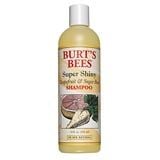 Burt’s Bees offers a varied line of shampoos, conditioners, and hair treatments. All Burt’s Bees hair care products are made from nearly 100% natural ingredients and are completely free of sulfates and chemical preservatives. Plus, they smell awesome and are renewable.
Burt’s Bees offers a varied line of shampoos, conditioners, and hair treatments. All Burt’s Bees hair care products are made from nearly 100% natural ingredients and are completely free of sulfates and chemical preservatives. Plus, they smell awesome and are renewable.
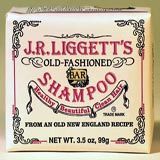 J.R. Liggett’s Old-Fashioned Bar Shampoo is a completely natural, vegetable oil-based solid shampoo that eliminates plastic bottle waste and, for many people, the need to use a conditioner. It’s available in several formulations, including some that are fragrance-free for those with sensitive skin or allergies.
J.R. Liggett’s Old-Fashioned Bar Shampoo is a completely natural, vegetable oil-based solid shampoo that eliminates plastic bottle waste and, for many people, the need to use a conditioner. It’s available in several formulations, including some that are fragrance-free for those with sensitive skin or allergies.
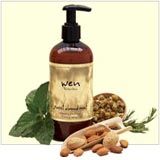 Wen Cleansing Conditioner is a blend of natural ingredients, without the harsh chemicals found in most shampoos, that is specially designed to clean, detangle, and deeply moisturize hair in one step. Other Wen hair products include a Styling Crème and a Hair Repair Mask for chemically treated hair. You can order Wen Cleansing Conditioner on Amazon.
Wen Cleansing Conditioner is a blend of natural ingredients, without the harsh chemicals found in most shampoos, that is specially designed to clean, detangle, and deeply moisturize hair in one step. Other Wen hair products include a Styling Crème and a Hair Repair Mask for chemically treated hair. You can order Wen Cleansing Conditioner on Amazon.
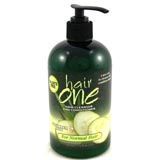 Hair One Cleanser Conditioner uses natural ingredients with astringent and antibacterial properties to clean hair without stripping it of its natural oils. Hair One is available in four formulas to provide targeted care for normal, color treated or dry/damaged hair, or to moisturize a dry scalp.
Hair One Cleanser Conditioner uses natural ingredients with astringent and antibacterial properties to clean hair without stripping it of its natural oils. Hair One is available in four formulas to provide targeted care for normal, color treated or dry/damaged hair, or to moisturize a dry scalp.